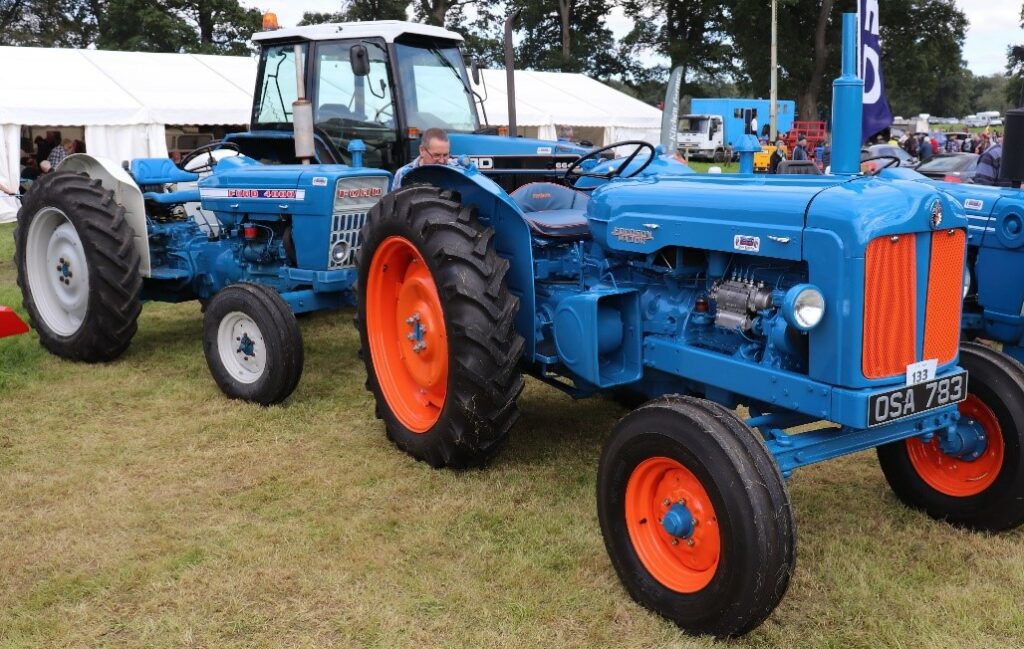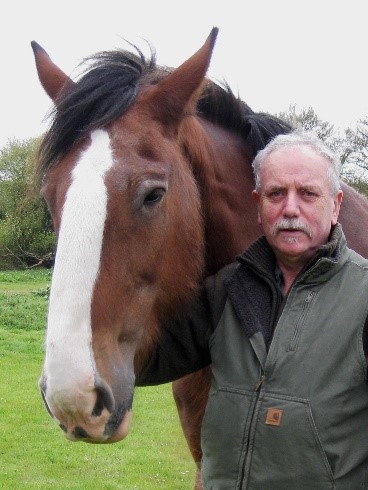Before I begin, I will blame this impromptu personal “blog” on our colleagues and friends, Cozette Griffin Kremer and Claus Kropp who suggested, nay twisted my arm, to write something to link two up and coming events.
As 2021 proceeds still under the effects of the Covid-19 virus, two related “virtual” events are occurring. Firstly, on May 8th ~ 9th, instigated and administered by Claus is his on-line Conference “Draft Animals in the Past, Present and Future.” (Figure 1). Secondly, following in an established tradition of the Association for Living History, Farm and Agricultural Museums (ALHFAM) is the Annual Conference’s “Plowing Match.” The latter too, usually a major event, is for the first time, and experimentally, virtual.

Encouraged by the late Peter Ledwith of the then Ontario Agricultural Museum, Milton, Canada, I joined ALHFAM back in 1993. At the time I was ‘Curator’ at the Weald & Downland Living Museum, near Chichester, West Sussex, England. It was June 1995 before I attended my first ALHFAM Annual Conference, which was held at Lake Farm Parks, Ohio. The weather was exceptionally hot. At that time there was no ‘Plowing Match’ but, as working livestock have invariably formed a part of the Annual Conferences, there was horse plowing. This aspect is for ever “burnt into my memory” for the ground was baked like concrete. I had never used a wheel-less walking plow before but what really threw me was that the plow being used was left-handed and totally alien to me (Figure 2). I was used to furrows always being thrown to the right. I since learned that left-handed plows were often favoured in Ohio.

Living in Scotland from 1997, I did not attend my next ALHFAM Annual Conference until 2002 when it was held at Fortress Louisburg, Nova Scotia. There was no Plowing Match but there was an opportunity to plow behind oxen, which at the time was my first occasion.
The following year, 2003, for which I sadly did not attend, the Annual Conference was held in New Jersey. The Conference incorporated Howell Living History Farm where the Director, ALHFAM Past President and our good friend, Pete Watson formally inaugurated the Annual ALHFAM Plowing Match. At Howell cultivation by both horses and oxen is the norm. Further, under Pete’s instigation, Howell has held its own draft animal Annual Plowing Match since 1983. Resultantly, Howell was the ideal place for the inauguration of the ALHFAM match and the start of an annual tradition.

The beauty of the ALHFAM Plowing Matches is that they are inclusive for all Conference comers; experiential and educational yet fun. When I reflect, apart from the comradeship, I think about the variety of plows that we have had the opportunity to try from 18th Century replicas at Colonial Williamsburg to 20th Century industrially manufactured models. I think too about the animals: mules, oxen and a variety of horses including ‘Canadian’ (Figure 3) when we were at Upper Canada Village in 2008.
When I further reflect, I think of a “brotherhood” that includes “sisters” of horse plowmen that has gelled over the years. I have had the honour of both being a judge and a winner of the competition. For the former, I think of melting as we judged (Figure 4) in the searing heat of Grapevine, Dallas, Texas in 2012. Before that at Baton Rouge, Louisiana in 2006, where with my good pal Ed Schultz from Colonial Williamsburg, we had to, first, literally wire a plow together for the Match. Then, second, at the end of the not only very hot but humid event, Ed and I running for “liquid refreshment”. Thinking about running, I recall being near Santa Fe, New Mexico in 2007 where lightning sent us running from the Match field for shelter. There has been much enjoyment and good memories. Over the years we have grown older, not necessarily wiser but it is good to see the events giving opportunities to especially younger participants who we hope will continue to be “tradition bearers.”

Although it is immaterial because of the positive outcomes, strictly speaking the ALHFAM “plowing matches” have not been really so but rather a version of furrow drawing contests, where each competitor follows on from the one before. In the past in England, for example, furrow drawing matches were wholly individual, where each competitor had to draw a single straight furrow across a field for judging that had no physical connection to anyone else’s. Now 2021’s Virtual ALHFAM Plowing Match will be different because in the true sense of a match and skill, each competitor will have to stand alone; plowing more than one furrow. In my vernacular, each competitor will have to “open out, plough three rounds with neat ins and outs to result in a level finish with all rubbish buried and no ‘gardening’ allowed.” In other words, for judging each competitor is going to have to start straight with their first two back-to-back furrows, followed by three ploughed furrows on either side of the opening furrows that will be judged for straightness, width and depth of furrow. Further, neat ends at the headland as the plough enters or exits each furrow, the efficiency of burying of surface growth and overall regularity and level of finish. Finally, no manual handling to enhance the final plowed result!
This change of the challenge may sound daunting to some. However, one of the principal aims is to encourage participation. We want entrants, ALHFAM members, to try and have fun. It is about the experience as well as about learning.
As I started, this is in the lead up to the “Draft Animals” conference and one important aspect of the ALHFAM Plowing Match has been to increase the awareness of the potential of draft animals (horses, mules and oxen) by giving a memorable hands-on experience.

That said, again 2021 will be different because we are introducing a tractor element. I am an ardent lifetime working horse enthusiast, yet I fully support this new initiative. In the mid-1960s, a good 50+ years ago, I started to drive on a 1950s Ferguson TE20 tractor, a 1959 “Massey Ferguson 65” and “Fordson Majors” before moving on to such as Ford 4 and 5000s. Having spent my career in living history museums, I have often thought that many of our fellow institutions are stuck, say in the early 1900s, a period when they were either founded or interpreted because their tangible or physical collections were nostalgic to the then audiences. I have been “retired” since the start of 2014 but before that I used to say to staff during annual training to remember that the parents visiting with their offspring may have been born since 1990. Of course, now you might say 2000! In the 1990s it became clear to me that many of our younger farming visitors had little idea about what we were exhibiting. I recall a radio program where young people were talking about the “old days”, the 1990s! I think that many of us, despite the potential for draft animals in existing and new contexts, realise that our representation of the “new” is often lacking. However, that “new” may be from 100 years ago. As a Curator I was pleased to include a 1950s Fordson “Super Major” and a 1960s Massey Ferguson 135 in our collection that were ticking the nostalgic senses of many similarly middle and older aged visitors to myself. That’s still a long time ago… 50 plus years and well before the experience of our current early 21st century audiences. OK, I’ll get off my soap box. Many of us know that there will be many ongoing challenges to collection, relevance and interpretation. However, with no threat to draft animals (my passion) intended, I am delighted that we are addressing an overdue need by the inclusion of tractors in our event.
In conclusion, may both of our related, “new normal” virtual events be successful. Claus’ Conference creates opportunities for further engagement to explore the past and future relevance of draft animals. The ALHFAM plowing match, is not only a means to encourage continuing engagement with a traditional skill but to also introduce a long overdue new aspect.
Speed The Plow… however drawn!
Bob Powell

Bob Powell is a working horse and farming historian, retired from the ‘Highland Folk Museum’, Scotland.
